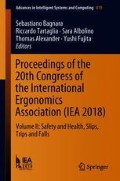Abstract
Introduction: In contrast to body postures during the entire day or during leisure, associations of work postures with acute myocardial infarction (AMI) have not been examined while adjusting for socioeconomic status, leisure time physical activity, fitness, and other CVD risk factors.
Methods: The associations between work postures (assessed by questionnaire at baseline) and 22-year incidence of first AMI (ascertained via record linkage with national registries) were estimated by Cox regression models adjusting for 19 confounders among 1831 Finnish men, separately for those with (n = 1515) and without (n = 316) pre-existing ischemic heart disease (IHD).
Results: In the full sample, work postures showed no substantial associations with AMI risk except for “standing quite a lot” (HR 1.26; 95%CI 0.94–1.70). The effects of work postures differed by baseline IHD status. Among men without IHD, sitting showed 7–16% reduced risks, standing 4–21% increased risks, and walking had no impact. Among men with IHD, walking showed 18–23% reduced risks, sitting “quite a lot” or “very much” showed 28% and 67% increased risks, respectively. Standing “a little” (HR 1.38, 95%CI 0.79–2.42) and “quite a lot” (HR 1.33, 95%CI 0.73–2.41) were positively but standing “very much” (HR 0.68, 95%CI 0.36–1.32) inversely associated with AMI.
Conclusions: Considering previously reported strong positive associations between standing and progression of atherosclerosis the latter finding is probably due to healthy worker selection bias. It is therefore prudent not to recommend standing at work for men with IHD and to always consider IHD status when assessing risks and benefits of different work postures.
Access this chapter
Tax calculation will be finalised at checkout
Purchases are for personal use only
References
Arrighi HM, Hertz-Picciotto I (1994) The evolving concept of the healthy worker survivor effect. Epidemiology 5:189–196
Coenen P, Willenberg L, Parry S, Shi JW, Romero L, Blackwood DM, Maher CG, Healy GN, Dunstan DW, Straker LM (2016) Associations of occupational standing with musculoskeletal symptoms: a systematic review with meta-analysis. Br J Sports Med 0:1–9. https://doi.org/10.1136/bjsports-2016-096795
Coenen P, Willenberg L, Parry S, Shi JW, Romero L, Blackwood DM, Maher CG, Healy GN, Dunstan DW, Straker LM (2018) Associations of occupational standing with musculoskeletal symptoms: a systematic review with meta-analysis. Br J Sports Med 52:174–181
Hayashi R, Iso H, Cui R, Tamakoshi A (2016) Occupational physical activity in relation to risk of cardiovascular mortality: the Japan collaborative cohort study for evaluation for cancer risk (JACC study). Prev Med 89:286–291. https://doi.org/10.1016/j.ypmed.2016.06.008
Krause N, Arah OA, Kauhanen J (2017) Physical activity and 22-year all-cause and coronary heart disease mortality. Am J Ind Med 60:976–990. https://doi.org/10.1002/ajim.22756
Krause N, Brand RJ, Arah O, Kauhanen J (2015) Ocupational physical activity and 20-year incidence of acute myocardial infarction: results from the Kuopio Ischemic Heart Disease Risk Factor Study. Scand J Work Environ Health 41:124–139. https://doi.org/10.5271/sjweh.3476
Krause N, Lynch JW, Kaplan GA, Cohen RD, Salonen R, Salonen JT (2000) Standing at work and progression of carotid atherosclerosis. Scand J Work Environ Health 26:227–236
Kristal-Boneh E, Harari G, Melamed S, Froom P (2000) Association of physical activity at work with mortality in Israeli industrial employees: the CORDIS study. J Occup Environ Med 42:127–135
Møller SV, Hannerz H, Hansen AM, Burr H, Holtermann A (2016) Multi-wave cohort study of sedentary work and risk of ischemic heart disease. Scand J Work Environ Health 42:43–51. https://doi.org/10.5271/sjweh.3540
Murtagh EM, Murphy MH, Boone-Heinonen J (2010) Walking – the first steps in cardiovascular disease prevention. Curr Opin Cardiol 25:490–496. https://doi.org/10.1097/HCO.0b013e32833ce972
Rempel D, Krause N (2018) Do sit-stand workstations improve cardiovascular health? JOEM Publ Ahead Print. https://doi.org/10.1097/jom.0000000000001351
Rose GA, Blackburn H, Gillum RF (1982) Cardiovascular survey methods. World Health Organization, Geneva
Smith P, Ma H, Glazier RH, Gilbert-Ouimet M, Mustard C (2017) The relationship between occupational standing and sitting and incident heart disease over a 12-year period in Ontario, Canada. Am J Epidemiol 187:27–33. https://doi.org/10.1093/aje/kwx298
Stamatakis E, Chau JY, Pedisic Z, Bauman A, Macniven R, Coombs N, Hamer M (2013) Are sitting occupations associated with increased all-cause, cancer, and cardiovascular disease mortality risk? A pooled analysis of seven British population cohorts. PLoS One 8:e73753
Tabatabaeifar S, Frost P, Andersen JH, Jensen LD, Thomsen JF, Svendsen SW (2015) Varicose veins in the lower extremities in relation to occupational mechanical exposures: a longitudinal study. Occup Environ Med 72:330–337. https://doi.org/10.1136/oemed2014-102495
Tüchsen F, Hannnerz H, Burr H, Krause N (2005) Prolonged standing at work and hospitalization due to varicose veins: a 12-year prospective study of the Danish population. Occup Environ Med 62:847–850
Tüchsen F, Krause N, Hannerz H, Burr H, Kristensen TS (2000) Standing at work and varicose veins. Scand J Work Environ Health 26:414–420
van Uffelen JG, Wong J, Chau JY, van der Ploeg HP, Riphagen I, Gilson ND, Burton NW, Healy GN, Thorp AA, Clark BK, Gardiner PA, Dunstan DW, Bauman A, Owen N, Brown WJ (2010) Occupational sitting and health risks: a systematic review. Am J Prev Med 39:379–388. https://doi.org/10.1016/j.amepre.2010.05.024
Author information
Authors and Affiliations
Corresponding author
Editor information
Editors and Affiliations
Rights and permissions
Copyright information
© 2019 Springer Nature Switzerland AG
About this paper
Cite this paper
Krause, N., Arah, O.A., Kauhanen, J. (2019). Working Postures and 22-Year Incidence of Acute Myocardial Infarction. In: Bagnara, S., Tartaglia, R., Albolino, S., Alexander, T., Fujita, Y. (eds) Proceedings of the 20th Congress of the International Ergonomics Association (IEA 2018). IEA 2018. Advances in Intelligent Systems and Computing, vol 819. Springer, Cham. https://doi.org/10.1007/978-3-319-96089-0_35
Download citation
DOI: https://doi.org/10.1007/978-3-319-96089-0_35
Published:
Publisher Name: Springer, Cham
Print ISBN: 978-3-319-96088-3
Online ISBN: 978-3-319-96089-0
eBook Packages: Intelligent Technologies and RoboticsIntelligent Technologies and Robotics (R0)

